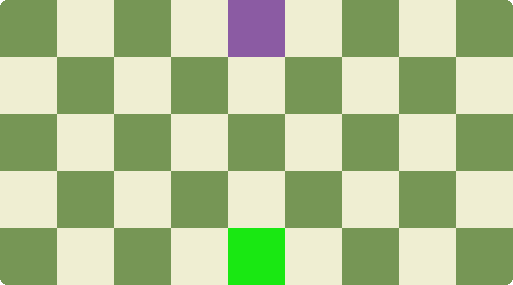
Event #63 Hide and Seek
This is an event that is part of a variant called event chess. More about event chess can be read here.
Event # 63 Hide and Seek
Type: Remove Check
Condition: At least 1 king for each player. Can not be started with another event requiring at least 1 king for each player.
Remove both kings from the board.
Both players choose a square and keep the chosen square hidden for his opponent. The chosen square can not be occupied by a piece and can not be threatened by an enemy piece.
Whenever an opponent is threatening to capture at the chosen square, then the square is revealed and the king is put on that square. The only exception is if this would result in the kings standing next to each other, then the king will not be revealed and the king will not be put onto that square.
Until the square is revealed the player that chose that square may not put a piece on that square.
If the opponent manages to put a piece on the chosen square, the square will remain hidden and cannot be revealed as long as a piece is standing on that square (can typically only happen if a pawn moves forward to that square or an enemy king is on that square).
Example 1:

White chose the square c3. Black chose the square g7.
If white plays Bb2 or Bh6, then he is threatening the g7 square. Black must reveal his chosen square and put his king there.
If black plays Rc7 or Rh3, then black is threatening c3. White must reveal his chosen square and put his king there.
White is not allowed to move his pawn to c3, but he is allowed to move the pawn to c4.
Black is not allowed to move his rook to g7, but allowed to move over that square to for example f7.
Example 2:

Black chose the square e5.
If white plays Qa1, Qb5, Qf4, Qf5 or Qf6, then he is threatening the e5 square. Black must reveal his chosen square and put his king there.
If white plays Kd4, Ke4 or Kf4, then the square will remain hidden since revealing it would result in the kings standing next to each other. In addition the game will end in a stalemate since black has no moves available.
Any other white move will also result in stalemate.
Example 3:

Black chose the square g7. Black will not reveal his chosen square, despite white threatening that square since the square is already occupied by a pawn. However if white moves his pawn and promotes to any piece, then he is threatening the g7 square, so black reveals his chosen square and puts his king there. Then he can take the promoted piece with his king if he wants.
Example 4:

Black chose the square d8. White chose the square d3.
If black would move the bishop it would result in his square revealed and the black king would be put into check. Moving your king into check is not legal, so black can not move his bishop. Black might argue that he knows the only possible square for whites king is d3 and checking it with Bb5 or Bf5 would reveal the white king and resulting in black to no longer be in check. However moves can not be done this way by assuming the opponents hidden square. The moves Bb5 or Bf5 are not legal.
Games: